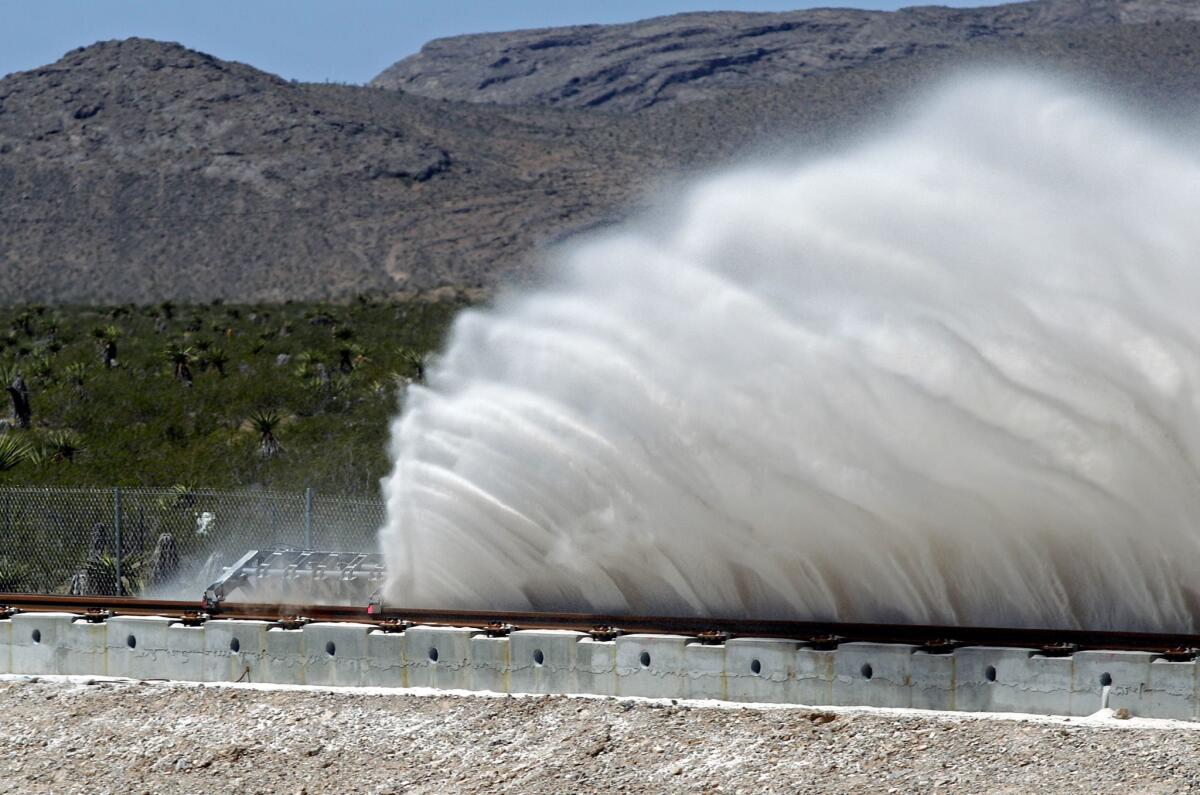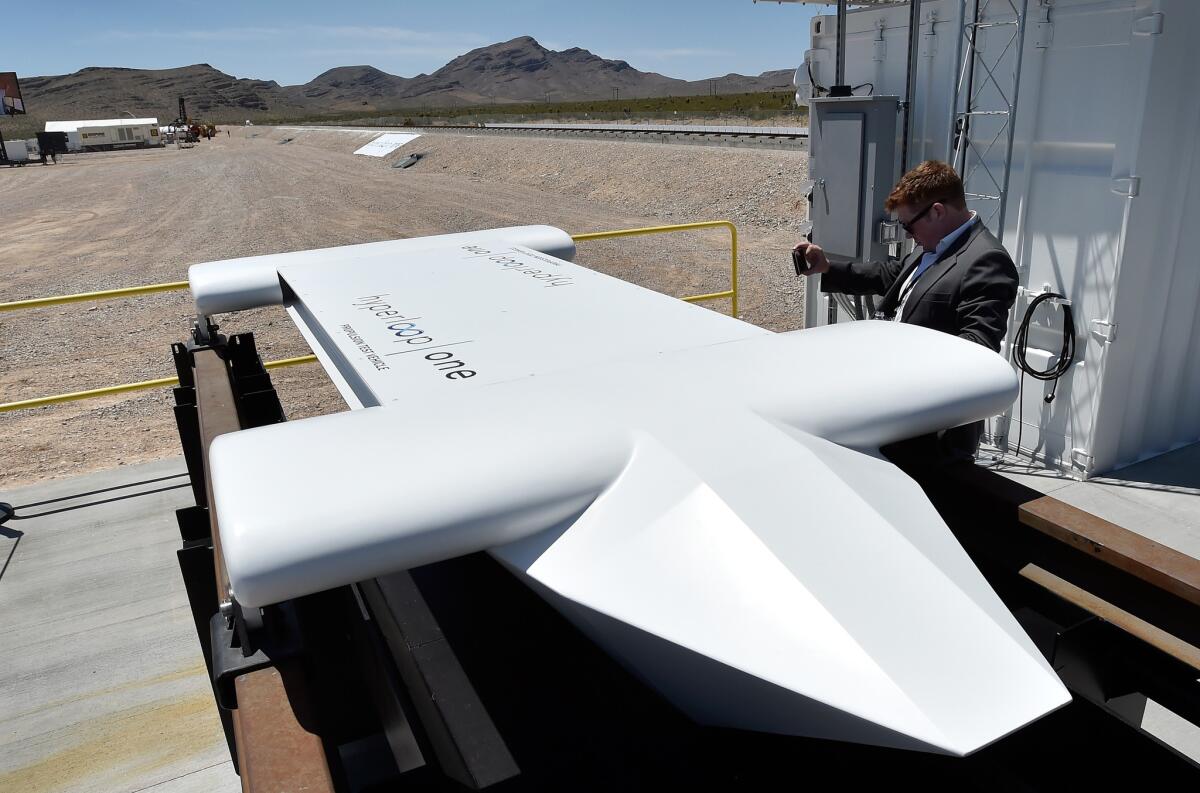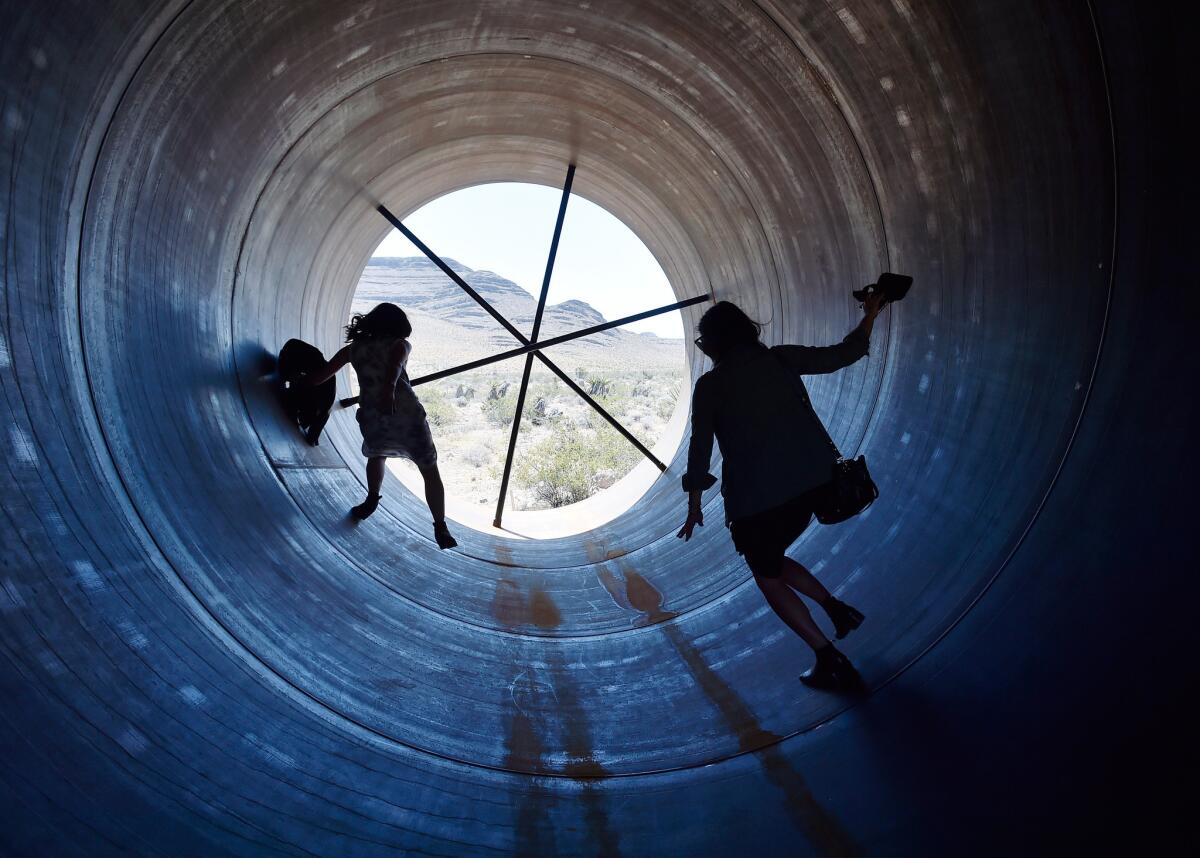Hyperloop One succeeds at first of many much-hyped tests

- Share via
Development of the nearly supersonic transportation system known as the hyperloop reached a new milestone Wednesday as entrepreneurs propelled a small sled about 100 yards at half its eventual targeted speed.
The demonstration before reporters in the north Las Vegas desert is the latest hype-building event for the hyperloop, a concept that business mogul Elon Musk made fashionable in 2013. Two Los Angeles companies, students across the country and others worldwide are trying to develop the propulsion, autopilot and safety technologies that would underpin a hyperloop system.
Hyperloop One Inc.’s Nevada showcase is expected to be among many from the industry as the downtown Los Angeles company and its competitors zip toward a full-scale test. That would happen by the end of the year in a best case scenario, said Hyperloop One, which had been called Hyperloop Technologies until Tuesday.
Even then, the hundreds of millions of dollars going into hyperloop research don’t represent a sure bet. Questions remain about what exactly the systems would look like and who would pay for them. And though significant development is happening in California and Nevada, early signs point to the first hyperloops coming to Europe -- if they materialize at all.
Musk intended to kill California’s long-delayed and costly high-speed rail project when he raised the possibility of erecting sealed tubes that would act as a sort of vacuum. They would suck vessels filled with people and cargo from San Francisco to Los Angeles in about 30 minutes. At 700 mph, or close to the sound barrier, they would be faster than any traditional high-speed rail system -- as well as more affordable and quicker to build, at least in Musk’s vision.
But on the eve of its test in Nevada, Hyperloop One announced that it would study placing hyperloops in Finland, Sweden and Switzerland. Its chief rival, Hyperloop Transportation Technologies Inc. in Playa Vista, previously said it was looking at the feasibility of hyperloops in Slovakia, Austria and Hungary.
The most likely scenario to bring a hyperloop to California would be one that ships goods from the docks in Long Beach and San Pedro to warehouses in the Inland Empire, Hyperloop One Chief Executive Rob Lloyd has said.
Almost any other major California project would require overcoming mountainous terrain and securing expensive real estate along farmlands and urban corridors. Both issues have slowed the state’s high-speed rail effort. Other countries offer fewer environmental and cost hurdles.
Lloyd’s 2-year-old company has raised $93.3 million by selling shares to more than 70 investors since December, according to regulatory paperwork filed Wednesday.

Recent investors include French National Rail, General Electric’s venture capital unit and Khosla Ventures, a Silicon Valley fund whose high-profile bets on clean technology have produced a mix record.
Lloyd, formerly a president at IT giant Cisco Systems, has called the hyperloop one of the best investment opportunities in decades, perhaps since the creation of the Internet.
“It’s the new broadband, for the movement of people and things,” he said in an interview this year.
The company has been working out of a warehouse in the Arts District, where Chief Technology Officer Brogan BamBrogan has introduced parts of the development process that experts credit for some of SpaceX’s success. BamBrogan, formerly known as Kevin Brogan, was an early employee at Musk’s SpaceX. The rocket-builder has focused on manufacturing its own parts to bring down costs. Likewise, Hyperloop One is exploring a similar setup.
Wednesday’s spectacle, with reporters watching from bleachers, saw a trapezoidal hunk of metal dart across a track. It slowed by crashing into a sand barrier, sending a large dust cloud into the air.
The electromagnetic propulsion displayed might be the hyperloop’s heart, but engineers are still determining how it will work with the technology’s lungs, brains and belly.
The more significant test would come when Hyperloop One brings the components together and attempts to accelerate a pod inside a miles-long tube as soon as this winter. Lloyd has described that potential milestone as the company’s “Kitty Hawk moment,” referring to the North Carolina town where the Wright brothers tested their airplane. Passenger travel on a hyperloop wouldn’t come until the early 2020s, according to Hyperloop One.
The other company, Hyperloop Transportation Technologies, hopes to break ground on its own track at the end of the year. Chief Executive Dirk Ahlborn congratulated Hyperloop One on its “amazing” progress in a short amount of time and expressed pleasure with the company’s name change. But he said the motor used Wednesday is hardly among the main innovation challenges.
“It’s a fairly old technology to move the cart along the tracks,” Ahlborn said. “It’s an important part but a very small part of what needs to be done.”

Ahlborn’s company said Monday that it would exclusively license magnetic levitation technology from Lawrence Livermore National Labs that will be crucial to the movement of its hyperloops. The technology will help reduce costs by eliminating the need for power stations along tracks because it doesn’t require electricity, he said. The company has meager funds compared with Hyperloop One, but workers can collect shares for their service.
Engineering and design firms such as Aecom and Arup have teamed with the hyperloop ventures to lend their expertise and monitor the progress, lest they be shut out of a big innovation.
An organization in the Netherlands is holding an open competition for ideas about how a hyperloop might fit in there. This summer, SpaceX plans to test student-created passenger bay designs on a track near its Hawthorne headquarters. The frenzy is helping bring more hype and investment to the industry.
“The time is right to bring new thinking to old problems and harness new technologies and services to make a quantum leap in transportation,” Lloyd said.
Twitter: @peard33
Join the conversation on Facebook >>
MORE BUSINESS NEWS
From coast to coast, middle-class communities are shrinking
Fox will bring New York Post gossip column ‘Page Six’ to TV
Stocks slump as Macy’s drags retailers sharply lower







